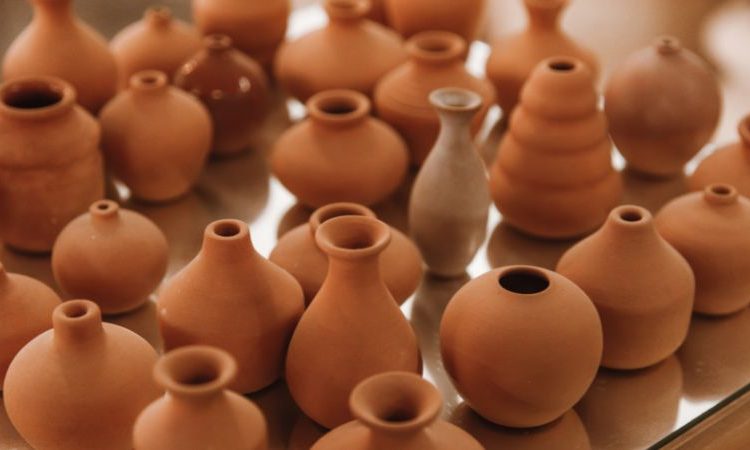With top-notch craftsmanship and low production costs, Vietnamese pottery is a darling to firms across the world. It offers a great package of quality, style options, and pricing that is suitable for many segments of the market.
In this guide, we’ll walk you through the most important things to consider before importing ceramics from Vietnam. From leading product types and famous craft villages to useful tips on sourcing, we’ve got everything covered.
Overview of Vietnamese Pottery in the Global Market
Vietnamese ceramics are increasingly becoming one of Vietnam’s most valuable handicraft exports. Recent trade statistics illustrate this good trend well. Mostly, even in only the first half of 2024 alone, Vietnam’s turnover of ceramics exports exceeds USD 317 million. That is an increase of nearly 10% compared to the same time in 2023.
Looking at some of the markets, America remains Vietnam’s biggest buyer of ceramics. The sales to America in just the first half of 2024 amounted to almost USD 81 million. This accounted for more than a quarter of the industry’s total export value and increased by a whopping 55.7% compared to the same duration last year.
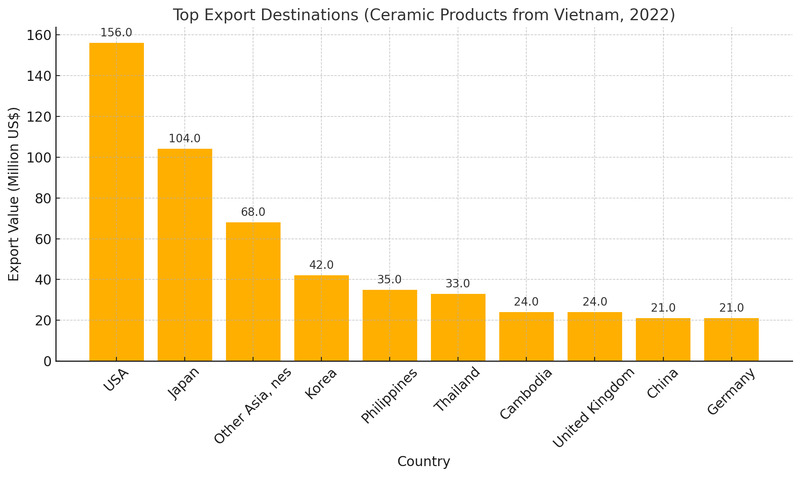
Vietnam’s ceramic industry will grow even larger in the long term. According to the Ministry of Industry and Trade, global demand for ceramic products — especially for artistic and high-end decorative items — continues to rise, particularly in markets like the U.S., Europe, Japan, and other ASEAN countries. With the support of new production technologies, skilled artisans, and competitive pricing, Vietnamese pottery and ceramícs are well-positioned to expand their presence on the global stage in the years ahead.
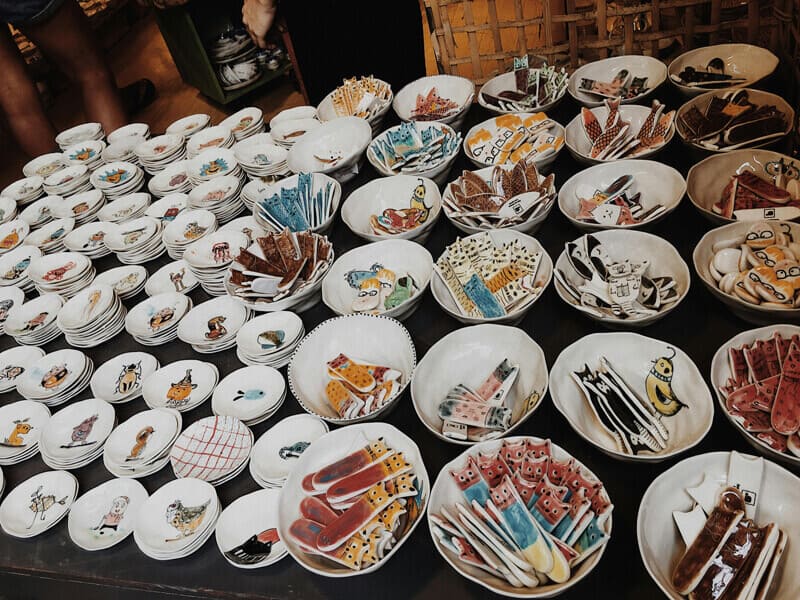
Pottery Styles You’ll Commonly Find in Vietnam
Vietnam boasts a history-spanning ceramics industry, and the cultural and art values of its ceramics continue to be unique. Some popular Vietnamese ceramic designs that are widely sought after nationally and globally include
1. Glazed Ceramics
This is the most well-known of the traditional Vietnamese pottery techniques. The pieces are glazed (basically a form of liquid glass) and then fired at high temperatures. When they’re fired, the glaze softens and sticks to the surface, forming a shiny, smooth layer that’s waterproof, dust-resistant, and low-maintenance to clean.
Vietnamese glazed ceramics are found in a variety of colors, but most commonly white, earthy brown, and jade green. Not only are the products pleasing to the eye, but they are also functional and durable. Some best-selling products include vases, dish sets, and decorative ceramic statues.
2. Unglazed Earthenware
Vietnamese ceramics also have their unglazed versions—those that are made from natural clay and fired without the glassy substance. Unlustered, as they would not be without glaze, the surface is harsh, reddish-brown in hue, and more absorptive, i.e., it will soak up water or stain after a while.
All of that aside, though, a lot of buyers are drawn to this type of pottery for its raw, natural beauty. It’s very simple and earthy in feel, something that works really well in outside or rural-themed settings. If you’re looking for that type of natural look, we would suggest exploring products like garden planters, wall reliefs, bricks, and ancient clay roofing tiles.
3. Cracked Enamel Ceramics
They belong to the glazed ceramics clan, but they differ from the rest in that they possess tiny cracks on their surface that form while firing them intentionally. The cracks form unique patterns—spiderwebs or bird footprints—and every single item acquires its own uniqueness.
Cracked enamel ceramics are usually white-grey, soft ash color. They possess a vintage and elegant character, so they are most commonly used for religious or feng shui items like incense burners, offering basins, decorative urns, and others. They are also appropriate in interior environments that carry an Asian touch, for example, hotels, restaurants, or resort complexes.
4. Blue-and-White Ceramics
It is among the most beautiful and recognizable forms in Vietnam ceramics. Blue-and-white pottery is known for its refined blue patterns, carefully brushed onto a glossy white surface. The motifs like to borrow from nature—trees, flowers, rivers—or from popular Vietnamese symbols such as dragons and phoenixes.
Blue-and-white pottery is used in a wide range of merchandise, from practical tableware like bowls, plates, and tea sets, to decorative pieces like figurines, paintings, and table sculptures. They are combined with excellent craftsmanship and beauty, making them a favorite for both home use and luxury home decoration.
Key Advantages of Sourcing Pottery Made in Vietnam
So, what makes Vietnamese pottery such a popular choice among buyers around the world? Here are some of the main reasons that make it stand out:
1. A Long History of Handmade Pottery
Pottery-making in Vietnam dates back a long time — all the way to the Neolithic period, around 10,000 years ago. The craft continued to grow throughout different historical periods. More so after the 10th century, when Vietnam had become an independent nation and began having dynasties of its own.
Even today, thousands of tiny villages across the country have generations of artisans who dedicate their lives to perfecting this craft. These artisans not only create beautiful objects; they also infuse every object with story and tradition.
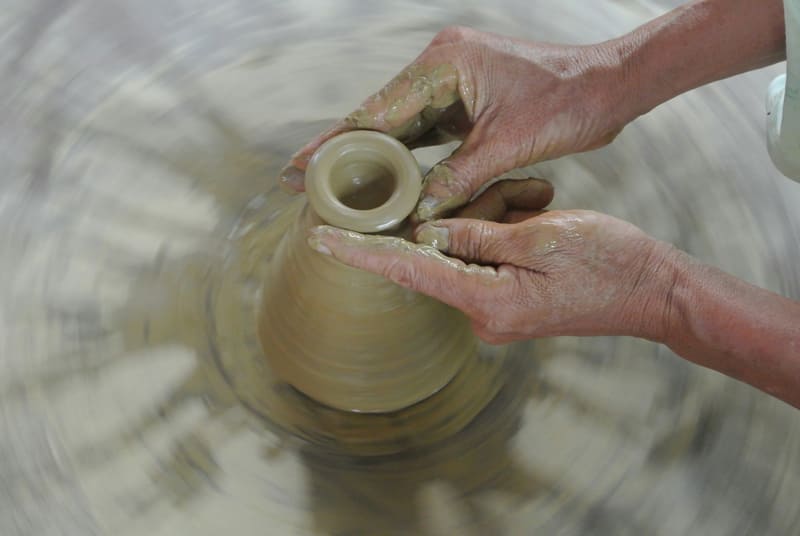
2. Cost-Effective without Compromising Quality
Indeed, the most compelling argument for purchasing Vietnamese pottery ware lies in cost-effectiveness without any loss of quality. Workers in Vietnam’s pottery industry usually earn around VND 10 to 15 million a month (about $430 to $650). In comparison, workers in China can earn between CNY 13,400 and 23,400 a month (around $1,870 to $3,270). That’s about 4 to 5 times more. As a result, buyers have the opportunity to purchase Vietnamese ceramics cheaper and to make better margins, especially when ordering in bulk.
All the same, cheaper doesn’t always mean compromised quality. The majority of Vietnam’s big producers nowadays impose stringent quality control and implement new technology to guarantee that items can achieve international standards of durability, heat resistance, and safety for food. ISO 9001, ASTM C1161, and EN 12875 standards are becoming more prevalent in the best producers.
3. Favorable Policies from the Government
Vietnam’s government is also playing an active role in supporting the growth of the pottery industry. One major initiative is Decision No. 801/QD-TTg — a national program focused on promoting handicraft exports. This program offers targeted support to ceramic-producing craft villages in key areas such as product diversification, trade promotion, and global market access.
On top of that, Vietnam’s National Single Window customs system is making export procedures simpler by cutting down on paperwork and speeding up clearance times. As a result, it’s now easier for international buyers to work directly with Vietnamese pottery manufacturers and source a wide range of ceramic products.
Disadvantages of Sourcing Pottery from Vietnam
Aside from the advantages that we have already mentioned, there are also a few potential disadvantages to watch out for when purchasing Vietnamese ceramics. Some of these are generic issues that buyers should take note of:
1. Quality Can Be Inconsistent Due to a Lack of Industrial Scale
While in China, ceramic factories are considerably mechanized and structured for mass production; the majority of Vietnamese pottery producers remain small family workshops located in traditional craft villages.
These businesses will grow more organically, with minimal industrial organization or planning. Usually, they rely on their family members to work for them and occupy rooms in their own residences. To top it all, many of them do not have the advanced equipment to increase output. This is why it becomes difficult for them to fulfill large foreign orders in time while keeping quality intact.
2. Communication and Cultural Differences
Variation in business culture and communication is another common problem, especially if you are speaking directly with small Vietnam pottery manufacturers in the old villages.
English fluency is also a possible obstacle. Though large factories or trading agents will have English-fluent staff, the majority of small family businesses are not English-savvy. That makes it simple for facts like product information, shipping dates, or shipping instructions to be easily misread if not plainly explained when communicating.
Time zone differences are another factor. Vietnam follows Indochina Time (GMT+7), which can lead to slower responses if you’re based in North America or Europe. And unlike some larger Chinese suppliers that offer round-the-clock customer service, most tiny workshops in Vietnam typically operate for just 8–9 hours a day, local time.
Types of Pottery Products You Can Source From Vietnam
Made-in-Vietnam pottery comes in many distinct product types, each catering to specific export needs and market trends. Some of the most commonly sourced and exported categories include terracotta planters, glazed ceramic pots, porcelain tableware, and stoneware vases. These product types are known for their aesthetic appeal, durability, and competitive FOB pricing—making them attractive for importers across Europe, North America, and the Middle East.
The following table outlines the key pottery types currently sourced from Vietnam, including their core features, minimum order quantities (MOQs), and estimated FOB prices:
| # | Type of Pottery | Key Features | MOQ (Estimated) | Estimated FOB Price (USD/unit) |
| 1 | Terracotta Planters | Unglazed red/brown clay, breathable, rustic appeal, ideal for gardening | 100–300 pcs/shape | $3–10 |
| 2 | Glazed Ceramic Pots | Wide range of colors and finishes, durable for indoor/outdoor décor | 50–200 pcs/design | $6–15 |
| 3 | Porcelain Tableware | Fine white clay, often hand-painted or blue-and-white, for dining & hospitality | 100–500 pcs/item | $2–8 |
| 4 | Stoneware Vases & Jars | High-fired, thick-bodied, matte or reactive glazes, export-grade quality | 50–150 pcs | $10–25 |
| 5 | Fiberstone/ Polystone | Composite concrete-like look, lightweight, used for oversized garden planters | Full container (20’–40’) | $15–30+ |
Major Pottery Production Villages in Vietnam
1. Bat Trang (near Hanoi)
The village now has around 620 workshops, most of them family-run. The techniques are still very traditional, with artisans using spinning wheels and shaping the clay by hand. Popular products include everyday items like bowls, plates, and tea sets, as well as flower vases, religious pieces, and larger decorative items like statues and ceramic wall art.
2. Phu Lang (Bac Ninh Province)
Phu Lang is about 60 km north of Hanoi. Like Bat Trang, it’s a village with a long history in pottery, but it focuses on a smaller range of products. Most of the Vietnamese pottery made here includes water jars and household containers, usually crafted from red clay.
What makes Phu Lang pottery special is its unique glaze. The artisans use a technique that creates crackled surfaces with colors like brown, dark yellow, or even black. The look is inspired by the texture and color of eel skin, which gives the pottery a very earthy, natural feel.
3. Thanh Ha (near Hoi An)
Thanh Ha has been producing ceramics since the 15th century and is known for its rustic and old-style pottery. Besides roof tiles and construction ceramics, the village also makes everyday household items like bowls, cups, and teapots. You’ll also find small animal figurines and handmade souvenirs like ceramic masks and ceramic lanterns.
Sourcing Methods: How Buyers Usually Work with Pottery Suppliers
Here are a few common ways to source Vietnamese pottery that international buyers usually go about it:
Tip #1: Visit Pottery Villages and Work Directly with Workshops
If you have time and a budget to visit Vietnam for a few weeks, this is a great option. You can meet the artisans, see how the pottery is made step by step (shaping, glazing, firing), and talk directly with the workshop about your needs. Many buyers often start with a small custom order, like a tea set with their own design, just to test quality and build the relationship.
In addition to well-known villages like Bat Trang, Phu Lang, and Thanh Ha, you might also check out places like
- Lai Thieu (Binh Duong province): renowned for household items (such as cups, teapots, vases) and decorative items (such as lamps and statues).
- Bien Hoa (Dong Nai province): famous for French-style ceramic art.
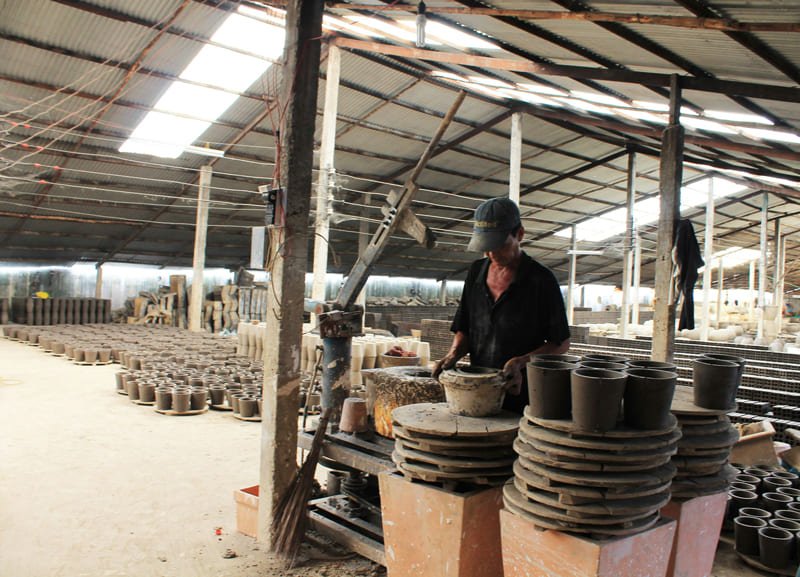
Tip #2: Meet Manufacturers at Big Trade Shows in Vietnam
If you want to meet a lot of Vietnamese pottery suppliers in just a few days, trade shows are a great way to do it. Events like Lifestyle Vietnam (usually held in October) and Vietnam Expo (often in December), both in Ho Chi Minh City, are worth checking out.
These shows bring together many local producers – you can see their products in person, compare designs and quality, and talk to them directly. It’s a good chance to get a feel for what they offer. After the event, you can follow up by email and maybe start with a small test order before going bigger.
Tip #3: Use Online Platforms (Vietnam Export, Alibaba, etc.)
If you need to start sourcing quickly or just want to get a feel for the market before coming to Vietnam, online platforms like Vietnam Export or Alibaba are a simple way to browse a wide range of Vietnamese pottery suppliers.
But since you can’t see or touch the products yourself, it’s always a good idea to check supplier profiles carefully. Look at how long they’ve been in business, what their production capacity is, whether they have proper quality certificates, and what past customers say about them. Also, always ask for samples before placing a large order.
Tip #4: Partner with a Local Sourcing Agent or Aggregator
Don’t worry if you can’t come to Vietnam to meet pottery makers in person or attend craft trade shows, because there are trusted local sourcing solutions like VinaSources.
VinaSources isn’t just a product listing site. It’s an all-in-one B2B sourcing platform built to help buyers see, evaluate, and connect with reliable pottery suppliers in Vietnam more easily. Every product we post goes through a standard review process. And every manufacturer we feature has to meet clear criteria in terms of operations, transparency, and ability to work with international buyers.
What’s most useful about VinaSources is that we don’t just help you find a supplier. We also make it easier to handle everything else involved in importing. Through our platform, you can connect with logistics companies, warehouses, payment services, customs brokers, and inspection teams — all in one place.
This way, you can save time, avoid costly mistakes, and reduce the risks that usually come with sourcing Vietnam ceramics from abroad. From checking factory info and certifications to reviewing product details and quotes, everything’s there to help you make faster and more confident decisions.
Ready to get started? Contact us now.
